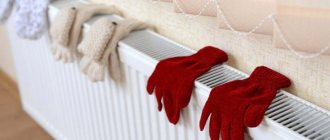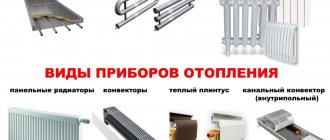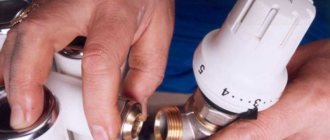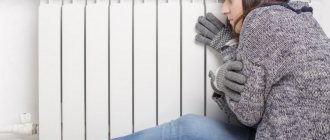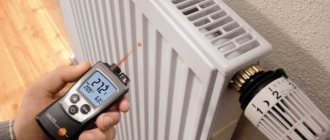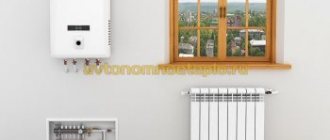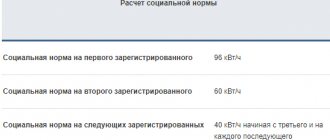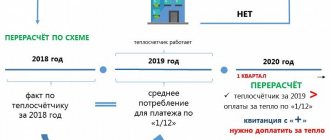Parameters for starting heating
As autumn approaches, the temperature outside becomes lower and lower, people touch their batteries every day and hope that today they will become hot. If this does not happen, then the residents look for the culprits, but in fact, all standards for the supply of heat to houses are specified in Resolution No. 354 of 2011.
This document states that heat is supplied at an outside temperature of 8 degrees Celsius, if it lasts for five days in a row . If this indicator fluctuates in one direction or the other over the specified time, then the radiators and risers in the apartments will remain cold.
Heat is supplied only on the sixth day and, as a rule, in most cases the heating season begins on October 15 and ends on April 15.
In this video you will learn the temperature standards in the apartment:
What laws regulate the supply of heat?
According to clause 5 of Part II of Decree No. 354 of May 6, 2011, heating is turned on when the average temperature outside drops below + 8° within 5 days. They stop supplying heat when in the spring, for five days in a row, the average temperature outside per day is + 8°.
In the central regions of the country, including Moscow, this happens most often from October 1 to October 15. Submission ends approximately April 15th. Dates may change due to weather conditions.
Unlike the capital, in the southern and northern latitudes the parameters are completely different. For example, in Magadan this period lasts from September 9 to June 16, and in Sochi - from November 15 to April 15. The exact start date of heat supply is always determined by the average outdoor temperature.
The beginning and end of the heating season are fixed in regulations of the local administration. Such a document is necessary for the correct calculation of heat supply standards and compensation for housing and communal services for beneficiaries.
Legislative acts do not apply to residential buildings with autonomous heating. Residents decide for themselves when and how to heat.
Standards for an apartment
Temperature standards in heating radiators are different for a particular room. The air in apartments should be heated to the following level:
- living area and kitchen - +18°C;
- corner apartments - +20°C;
- bathroom and toilet - +25°C.
Corner apartments should be heated more strongly due to the presence of cold corner walls. The standards for common premises are slightly different:
- entrance — +16°C;
- elevator — +5°C;
- attic and basements - +4°C.
Measurements in a residential area are made on the internal walls no closer than a meter from the outer wall and one and a half meters from the floor level.
If the parameters do not comply with the standards, the consumer must notify the management company. After the required checks, the heat charge can be reduced by 0.15% per hour of deviation from the standards.
Calculation of heating operating temperature conditions
When calculating heat supply, it is necessary to take into account the properties of all components. This is especially true for radiators. What is the optimal temperature for heating radiators – +70°C or +95°C? It all depends on the thermal calculation, which is performed at the design stage.
An example of drawing up a heating temperature schedule
First, it is necessary to determine the heat losses in the building. Based on the data obtained, a boiler with the appropriate power is selected. Then comes the most difficult design stage - determining the parameters of the heat supply batteries.
They must have a certain level of heat transfer, which will affect the temperature chart of the water in the heating system. Manufacturers indicate this parameter, but only for a certain operating mode of the system.
If to maintain a comfortable level of air heating in a room you need to spend 2 kW of thermal energy, then the radiators must have a no less heat transfer rate.
To determine this, you need to know the following quantities:
- The permissible maximum water temperature in the heating system is t1. It depends on the power of the boiler, the temperature limit on the pipes (especially polymer ones);
- The optimal temperature that should be in the heating return pipes is t This is determined by the type of pipeline layout (one-pipe or two-pipe) and the total length of the system;
- The required degree of heating of the air in the room is t.
Having these data, you can calculate the temperature difference of the battery using the following formula:
Tnap=(t1-t2)*((t1-t2)/2-t3)
Next, to determine the power of the radiator, use the following formula:
Q=k*F*Tnap
Where k is the heat transfer coefficient of the heating device. This parameter must be indicated in the passport; F – radiator area; Tnap – thermal pressure.
By varying various indicators of the maximum and minimum water temperatures in the heating system, you can determine the optimal operating mode of the system. It is important to correctly initially calculate the required power of the heating device. Most often, the low temperature indicator in heating radiators is associated with heating design errors. Experts recommend adding a small margin to the obtained radiator power value - about 5%. This will be needed if the outside temperature drops critically in winter.
Most manufacturers indicate the heat output of radiators according to accepted standards EN 442 for mode 75/65/20. This corresponds to the normal heating temperature in the apartment.
Battery temperature
There are minimum and maximum standards. Sometimes, even when heating is started, there is not enough heat in the room due to the fact that the temperature of the radiators is far from the standards. The reason for this is the banal airiness of the system. You can fix the problems with the help of a specialist or yourself using a Mayevsky crane.
If the problem arises due to worn-out riser pipes or batteries, then you simply cannot do without the help of specialists. If the heating system did not work and the air in the apartment was colder than specified in GOST standards, then this entire period is not subject to payment.
There are no minimum temperature standards for heating radiators, so it is customary to rely on the air parameters in the apartment. Normal air parameters during the heating period are +16…+25°C.
To document that the temperature of the heating system does not meet the norm, it is necessary to invite an authorized representative of the heating service provider. What the water temperature in the batteries should be is described in SNiP 41−01 of 2003:
- If a two-pipe design is used in the room, then 95°C is the maximum.
- The norm for a single-pipe design is +115°C.
- The winter temperature norm for heating radiators in an apartment is +80…+90°C. If it approaches +100°C, then urgent measures must be taken to prevent water from boiling in the system.
Although many battery manufacturers often specify a maximum temperature threshold that is high, you should not reach it frequently as this will damage the battery.
To ensure that the heating complies with GOST standards, you need to take your own measurements and understand what the temperature of the water in the heating radiators is:
- An ordinary mercury thermometer can be used, but then 2°C will need to be added to the result obtained.
- An infrared thermometer will also work.
- The alcohol thermometer must be tightly tied to the battery, wrapped in thermal insulation.
If the results obtained are far from normal, then you need to submit an application to the heating network office with a request to carry out control measurements . A commission will visit the apartment and make all the necessary calculations.
Answer
There is a problem with hot water and heating in our house. We haven’t had good hot water since 2006; the water constantly needs to be drained to get hot water. The housing office and Kievenergo (a vicious circle, they pass the needles on each other), they say that the circulation system does not work, they say it is broken, it needs to be repaired, they promise and promise, but no one wants to do anything. As the mechanic from the housing department explained, at the entrance to the house the pipe is open, it is hot, but at the exit it is blocked, there is damage somewhere along the route, and if we open the pipe at the exit, circulation will begin, and we will have hot water, but there will be a pressure of water and will begin to heat the basement and chambers of the neighboring house, so it turned out to be easier not to repair, but to simply turn off the valve in the basement of our house. Regarding heating, the problem has been since last year, in the apartment all the radiators are of different temperatures, in my apartment: the kitchen is hot, the large room is warm, the small room is cold. It’s different for everyone at our entrance, but there are those who have boiling water on all their batteries, but this wasn’t the case before. The Housing Office shrugs and refers to Kievenergo, but they do the opposite. A commission from the housing office comes, measures the air temperature, and the temperature norm is maintained thanks to the air conditioner, heater, gas stove and insulated walls. Recently they came to measure it again, the walls in my apartment are insulated, at a temperature outside of +4, it was 19 degrees in my apartment, and the funny thing is, the neighbor above me has no insulated walls and is also 19, all the neighbors have 19-20. But when it was -11, with my insulated wall it was +16 degrees. The Housing Office simply turns a blind eye to everything and doesn’t want to do anything. We have written complaints more than once to the Kyiv City State Administration, to the Obolon administration, to ZHITLOSERVICE “OBOLON”, all applications are sent to the Housing Housing Authority, but they don’t want to do anything. Everything is useless, they make fools of us, complete ignorance and indifference, and you pay for hot water and heating, despite the fact that they are not there. Write an application every month for recalculation, stand in line for 3-4 hours, wait for representatives from the housing office 3 times a month to measure the water temperature, and they come without warning... any normal, working person simply does not have this time. A collective complaint from the entrance is not allowed. What do we need to do so that the services we pay for finally become high-quality, because we have every right to them? Please tell me where and who else we need to contact, with what documents, so that at least something can finally move forward? Thank you in advance.
Actions in the absence of heat
If there is any discrepancy between the heating system and GOST, you need to find the cause of the cold radiators. The best person to deal with this will be the specialists of the supplier company, who will be able to officially record the temperature in the living room.
If the problem is caused by poor quality maintenance of the systems of an apartment building, then the solution to the problem lies entirely with the organization supplying the heat. At the same time, all residents should be recalculated for heat or they should be completely exempt from paying if the radiators did not heat at all.
Any application from the residents of the house to the communal structure must be considered as soon as possible, and the commission must record on the spot the fact of inadequacy of the services provided.
Knowing what the temperature of the radiators in the apartment should be and at what period the heating starts, each resident of an apartment building can determine for himself whether the temperature indicators comply with the established standards. This will help you take action in time and solve the heat problem.
Water temperature in the boiler and heating pipes
After performing the above calculation, it is necessary to adapt the heating temperature table for the boiler and pipes. During heat supply operation, emergency situations should not occur, a common cause of which is a violation of the temperature schedule.
Heating boilers
The normal water temperature in central heating radiators can be up to +90°C. This is strictly monitored at the stage of coolant preparation, its transportation and distribution to residential apartments.
How to determine that the water temperature in the radiators is below normal?
A device that measures surface temperature with a beam.
The quality of heating is often determined by the air temperature in the room. If you feel that the rooms are cool, you need to measure the temperature. The maximum permissible temperature is +18 degrees. If it is lower, then you need to identify the cause. The main reasons may be leaky windows and doors, but a more compelling reason is low water temperature in the radiators.
To determine what the temperature of the batteries in your apartment should be, there are special calculations. They are compiled by specialists who compare the temperature of the water in the radiators and the ambient temperature. You need to call a special service that will measure the temperature in the heating radiators in your apartment. The obtained data is compared with the temperature graph data. This graph has already calculated what temperature should be in the direct and return water supply pipes.
Table. Temperature graph of the ratio of heating to ambient temperature.
| Ambient temperature | Direct water temperature | Return water temperature |
| -15 | 105 | 70 |
| -10 | 92 | 63 |
| -5 | 78 | 56 |
| 65 | 48 | |
| +5 | 50 | 39 |
These data are given for a single-pipe heating system, with water supplied from bottom to top. According to the table, when the outside air temperature is, for example, -10 degrees Celsius, the return water temperature should be at least 63 degrees. And this does not depend on which floor the measurements are taken - on the first or fifth. In a two-pipe heating system, the water temperature at -15 outside is allowed to be 95 degrees with direct water supply.
Each locality has its own temperature chart. It is approved by the city administration.
If the battery temperature in the apartment is below normal, this means that the boiler room is saving on heating. After water measurements, specialists draw up a report, and utility workers must correct all problems. At the same time, everyone has the right to demand a recalculation of heating fees. The rent should be reduced according to the square footage of the apartment. The temperature of the water in the radiators is one of the main factors in a warm home. According to battery temperature standards, a coolant must be supplied to the apartment, the degree of heating of which ranges between 80-85 degrees.
It is very simple to make heating with heating elements in your home, and each heat exchanger will not depend on the others. To do this, simply screw the heating element into the bottom end of the battery and connect it to the electrical network.
Here you will find everything about infrared heating of a private house: reviews, calculations and drawings.
Ways to reduce heat loss
The above information will help to be used to correctly calculate the coolant temperature norm and tell you how to determine situations when you need to use a regulator.
But it is important to remember that the temperature in the room is affected not only by the temperature of the coolant, street air and wind strength. The degree of insulation of the facade, doors and windows in the house should also be taken into account
To reduce heat loss from your home, you need to worry about its maximum thermal insulation. Insulated walls, sealed doors, and metal-plastic windows will help reduce heat loss. This will also reduce heating costs.
First, let's look at a simple diagram:
In the diagram we see a boiler, two pipes, an expansion tank and a group of heating radiators. The red pipe through which hot water flows from the boiler to the radiators is called DIRECT. And the lower (blue) pipe through which colder water returns is called REVERSE. Knowing that when heated, all bodies expand (including water), an expansion tank is built into our system. It performs two functions at once: it is a reserve of water to replenish the system and excess water goes into it during expansion from heating. Water in this system is a coolant and therefore must circulate from the boiler to the radiators and back. Either a pump or, under certain conditions, the force of earth's gravity can force it to circulate. If everything is clear with the pump, then with gravity many may have difficulties and questions. We have dedicated a separate topic to them. For a deeper understanding of the process, let's look at the numbers. For example, the heat loss of a house is 10 kW. The operating mode of the heating system is stable, that is, the system neither warms up nor cools down. The temperature in the house does not rise or fall. This means that 10 kW is generated by the boiler and 10 kW is dissipated by the radiators. From a school physics course we know that to heat 1 kg of water by 1 degree we will need 4.19 kJ of heat. If we heat 1 kg of water by 1 degree every second, then we will need power
G=Q/(4.19*dT)=10/(4.19*10)=0.24 kg/sec.
Can water in a well freeze? No, the water will not freeze, because... In both sandy and artesian wells, the water is below the freezing point of the soil. Is it possible to install a pipe with a diameter greater than 133 mm in a sand well in a water supply system (I have a pump for a large pipe)? When installing a sand well, it does not make sense to install a pipe with a larger diameter, because Sand well productivity is low. The Malysh pump is specially designed for such wells. Can a steel pipe in a water supply well rust? Quite slowly. Since when constructing a country water supply well it is sealed, there is no oxygen access to the well and the oxidation process is very slow. What are the pipe diameters for an individual well? What is the productivity of a well at different pipe diameters? Pipe diameters for constructing a water well: 114 - 133 (mm) - well productivity 1 - 3 cubic meters per hour; 127 - 159 (mm) - well productivity 1 - 5 cubic meters ./hour; 168 (mm) - well productivity 3 - 10 cubic meters/hour; REMEMBER! It is necessary that...
Type
Methods for measuring water in radiators
When considering the question of how to measure the temperature of a battery in an apartment, the following methods can be distinguished:
- an ordinary thermometer (on the surface of the radiator);
- infrared thermometer;
- alcohol thermometer;
- special electrical device.
When measuring with a regular thermometer, you need to add 1-2 degrees to the result. A more accurate result will be given by an infrared device, the error of which is 0.5 degrees.
In order to regularly monitor the temperature of the water in the batteries, you can use an alcohol thermometer. To do this, the device is attached with tape to the radiator and wrapped in heat-insulating material.
The battery may not heat up evenly.
You can also use an electric version of the thermometer for measurements. To do this, a wire with a thermocouple is wound to the battery, and it takes readings of the degree of heating. If a consumer calls a special commission to measure the temperature of heating radiators in an apartment, then their device must have a quality certificate and first pass state inspection. The actions of specialists must comply with GOST 30494-96 (clause 4 in the “Control methods” section).
If the temperature of the heating pipes in the apartment is higher than normal, then it can be adjusted in several ways:
- using special devices;
- ventilation;
- using thick curtains.
There are special taps with which you can regulate the temperature. They are installed on each radiator. A simpler method is to ventilate the room. You can also simply use curtains made of dense material, which will let less sunlight into the room. It is much easier to deal with high room temperatures than low ones. What to do if the minimum temperature of the batteries in the apartment is lower than indicated in the temperature chart? To do this you should:
- call utility services;
- insulate windows, doors and walls;
- install new radiators.
If you don’t know how to check the temperature of the batteries in the apartment, you can call specialists. Also read: “Blowing and cleaning batteries.”
Utility services measure plumbing and heating systems. After this, an act is drawn up. Then, if the tenant's claims are confirmed, utility companies must increase or decrease water heating. Another way would be to install new heating radiators. Details about the installation can be found in the video:
You should pay attention to the material from which the batteries are made.
Aluminum radiators have high thermal conductivity, so they will transfer heat well. But cast iron, although they are able to retain heat longer, will release it more slowly. Because of this, the room will take a long time to warm up.
The speed of water movement also affects the temperature in the heating pipes in apartments. Don’t forget that corner apartments are always cooler, because they have more walls in contact with the street. To reduce heat loss, it is necessary to insulate the walls. Insulating windows and doors through which cold air enters will also not be superfluous.
Even the most fashionable and modern infrared heating of a private home consumes the same amount of electricity as any other electric heater of equal power, even the most ancient one.
You can read more about infrared heating and energy consumption in this article.
There was not enough heat: reasons for different temperatures in apartments of the same house
The thermal power plant supplies coolant to absolutely all houses at the same temperature - according to a schedule approved by the city administration and to which the dispatcher of the heating network department is guided, based on the outside air temperature. The colder it is outside, the hotter the coolant in the pipes. The optimal temperature of the coolant in the pipes inside the house is +75 °C, it remains until the temperature outside the window drops below –20 °C.
Once inside the houses, the coolant begins to evenly fill the risers and radiators in all apartments on the first or last floor, depending on the wiring inside the house. In this way, all pipes and radiators are filled sequentially across floors. But despite this, rooms in apartments warm up differently. And the reason for this is the design features of residential buildings.
Corner apartments
Residents of corner apartments feel the temperature difference and lack of heat the most. Depending on the layout of the house, the walls of one or two rooms in corner apartments border the street, and not the neighboring apartments. That is, in a corner apartment, unlike a regular one, two or four walls are exposed to direct contact with the outside air. Since the cooling area of corner apartments is larger, the rooms in them are cooled faster than they receive heat. Therefore, according to SanPin, the temperature in corner apartments should be 2–4 degrees higher than in a regular apartment.
To achieve a temperature in the rooms that is comfortable for residents of corner apartments, you need to increase the temperature of the coolant inside the house. This can be done by a specialist from the management company at an individual heating point in the basement of the house. At the same time, it is important to configure the heating point devices so that residents of ordinary apartments do not feel stuffy and there is no overheating.
Sometimes, due to the characteristics of an individual heating unit, most often in houses built before 2010, it is impossible to perfectly configure the devices so that residents of corner and standard apartments are equally comfortable. Experts make a choice in favor of the majority, and during prolonged frosts, residents of corner apartments feel a lack of heat.
Purpose of the premises
Residents often ask about the temperature difference in the living room and hallway. The temperature in the entire apartment should not and cannot be the same. After all, each room, depending on its purpose, has its own optimal and acceptable minimum parameters, which are established by SanPin and GOST standards.
1. Make sure there is no draft in the room, as well as the quality of the window insulation: there should be no gaps or cracks between the wall and the window frame or the window sill and the window, otherwise cold outside air will enter the living space through them. 2. Close windows and interior doors tightly. 3. Use a household thermometer for measurements.
4. Measurements should be taken at a distance of 1 meter from the floor and 1 meter from the radiator.
5. Take measurements in cloudy weather or in rooms on the shady side.
6. To ensure the objectivity of the result, repeat measurements indoors with an interval of 2.5–3 hours.
If the temperature in any room in the apartment differs from the standard value by more than 3 degrees, you need to contact the specialists of the management company and ask them to adjust the heat supply, and also check the permeability of the pipes that heat the problem room.
Energy efficiency at home
The energy efficiency of a home is the ability to retain heat for as long as possible. At the same time, in a poorly insulated house, not only corner apartments, but absolutely any apartments and rooms in them can lose heat or cool down.
The problem of energy efficiency is typical for houses built before 2000, and most often panel houses. Measurements of heat loss in apartment buildings using a thermal imager were carried out in Novosibirsk on February 24, 2021
For example, apartments on the first floors, in which the wall of the room borders the entrance. The lack of heat can be felt due to the fact that a radiator is not installed in the entrance - and the wall freezes. In this case, you must contact the management company with a request to install an additional covering or radiator on the wall. This will help increase the temperature in the entrance and prevent ice from appearing on the wall on the side of the apartment during prolonged frosts.
If, before the start of the heating season, the management company has not sealed the joints between slabs in panel houses with sealant, as necessary, living rooms may lose heat through the corner space. After all, it is at this point that the joints of the concrete slabs from which the house is made occur. Because heat will leak out into the street through the cracks between the panel blocks, into which cold air will instead enter.
Apartments on the upper floors also suffer from lack of heat. If the attic of a house is not insulated or insulated incorrectly, the ceilings in the apartments do not warm up, but cool down due to drafts in the attic rooms.
But not only the management company should care about the energy efficiency of the house. Homeowners are also required to take certain actions to maintain heat.
If all participants in the heat supply process, from thermal power plants to homeowners, fulfill their duties to conserve heat, then even during prolonged frosts, residents will be able to avoid heat loss and freezing of apartments.
What should you know about the temperature in heating radiators in an apartment?
You can screw a thermal head into the end of the battery.
To live comfortably in an apartment, you need to monitor the temperature of the batteries. To do this you need:
- independently measure the temperature of the pipes (use regular, infrared, alcohol thermometers or a special electrical device with a thermocouple);
- call utility workers if the temperature does not meet the standards (as a rule, it is lower than required);
- if the temperature of the battery during the heating period in the apartment is higher than normal, then special taps can be used to regulate it.
A pleasant microclimate in an apartment is the key to health, so do not neglect it. In addition, the degree of air humidity plays a crucial role. If it is too dry, respiratory problems may result. The amount of fresh air is also standardized for each room separately. According to many experts, the standards are somewhat too high, so even if the air exchange is only half, this is quite acceptable.
The annual rise in price of resources forces the end consumer to think not only about their savings, but also about the quality of the utility services provided. One of the most significant expense items in paying for an apartment is heating, so consumers monitor its parameters especially carefully. To do this, it is worth finding out what the normal temperature of the batteries in the apartment is in 2019.
Temperature standards for the heating system in an apartment building
The heating circuit in apartment buildings is built in cooperation with a centralized system to which the pipes are connected. Through them, the coolant is directed to the apartment building, where its further supply is regulated by inlet valves. After this, the water goes through the risers and eventually ends up in the radiators and radiators of each apartment.
The described processes, as well as everything related to the rules for providing the population with utility resources, are reflected in the Decree of the Government of the Russian Federation dated May 6, 2011 No. 354 “On the provision of utility services to owners and users of premises in apartment buildings and residential buildings” (hereinafter referred to as Decree No. 354). Heating quality requirements are set out in Section VI of Appendix No. 1 to the rules of Decree No. 354.
In addition, detailed rules for the provision of heating services are prescribed in the Order of Rosstandart dated June 11, 2014 No. 544-st “GOST R 51617-2014. National standard of the Russian Federation. Housing and communal services and management of apartment buildings. Public utilities. General requirements" (hereinafter - GOST R 51617-2014) and "GOST 30494-2011. Interstate standard. Residential and public buildings. Indoor microclimate parameters”, approved by order of Rosstandart dated July 12, 2012 No. 191-st (hereinafter referred to as GOST 30494-2011).
These acts establish the parameters of the coolant for the heating system of an apartment building. Thus, the temperature of the coolant (water) when supplied to the system is equal to the temperature of the water when it leaves the heating boiler. As a rule, the coolant should be brought to a temperature of 130-150 °C, but this indicator also depends on the outside temperature in the region.
Typically, the water leaving the boiler should have a temperature of 115 °C.
However, the standard temperature in the heating system can be within 95 ° C or 105 ° C (for different systems).
Next, to create comfortable conditions in the room, the proper condition of the parameters of the riser, which conducts water from the heating unit to the apartment, is ensured. They vary depending on the summer and winter seasons.
Of course, in practice, the temperature of the coolant in the riser depends on the operation of the thermal power plant and on heat loss on the way to the house. However, the riser temperature in winter should be in the range of 70-90 °C.
What should the temperature of the radiators be?
The traditional coolant in the MKD heating system is water heated to 90°. Initially, when leaving the boiler it is much hotter, but on its way to the consumer, heat loss and partial cooling inevitably occur.
Coolant temperature at different stages
The boiler room or thermal power plant heats the water to 115–120° and supplies it to the heating network. You will be surprised how thermal engines manage to heat it without letting it boil. It's all about the high pressure under which the carrier is supplied. The boiling water cools down in the pipes. At the heating points of the apartment buildings, it is additionally cooled to 80–90° and distributed among the internal communications. Without cooling, the heating system will overheat. As a result, pipes and radiators will fail, and residents may get burned by leaning against overheated radiators.
Heating depends on the average temperature outside. At the beginning of the heating season and before its end, when the air is still warm, the water is supplied to the pipes relatively cool - only 70 degrees. In late autumn and winter it is made hotter. As a result, the temperature in the internal pipes increases to 80–90 degrees. This is the limit - radiators and risers should not be hot on the outside. According to SNiP 41–01–2003, their surface cannot be warmer than 75° in order to protect consumers from burns.
The thermal parameters of the medium supplied to MKD and other consumers are regulated by SNiP 41-02-2003 - “Heating networks” and SNiP 41-01-2003 - “Heating and ventilation”.
Why do batteries heat up differently?
The temperature of the radiators depends on the design of common building communications - the older the building, the greater the heat loss and the colder the rooms.
- Heating is lost most strongly in single-pipe systems, where supply and drainage occur in the same pipe. The radiators are connected in series one after another, and the coolant gradually cools down as it passes through them. Therefore, in one apartment building there are “warm” and “cool” rooms. Single-pipe structures are installed in Khrushchev and Stalin buildings.
- The water inside the pipes cools a little slower in the “Leningradka” - an improved single-pipe system that provides for the connection of bypass routes. This design is also found in old MKDs.
- In two-pipe systems installed in Brezhnevkas and new high-rise buildings, outflow and supply are carried out in separate branches, so the water does not mix and does not cool down for a long time.
- The least losses come from a modern radiant heating system, where the radiators are connected in parallel and do not affect each other.
Autonomous heating is very convenient. In this case, heating is carried out in a mini-boiler room or boiler installed in the basement or next to residential buildings. This reduces heat loss, and residents will be able to reduce or increase heating, reducing heating costs. Such heating systems are now being installed in private households and new apartment buildings.
What is the temperature of the carrier in different thermal systems
SNiP 41-01 of 2003 specifies standards for various types of communications:
- In a single-pipe system, the coolant is heated to 105°. This is inconvenient because you constantly have to fight against its boiling. But there is simply no other way - the water, after passing through the heat devices installed in series, will quickly cool down.
- In a two-pipe design, the coolant is colder - only 95°. Compared to the single-pipe option, the risk of boiling is much lower here, which means that the elements of the heating system will last longer.
- In modern high-rise buildings, the water in the heating lines is heated to approximately 80–90°. This is enough to maintain the required temperature.
Air temperature standards in the apartment
The feeling of comfort from heating a room is subjective. However, there are uniform standards determined by the physiological needs of a person, as well as the purpose of the premises in which he resides.
Although there is a fairly wide range of standards that prescribe what the temperature of the water in the heating system of an apartment building should be, the standards for the thermal conditions of the air in the apartment are very unambiguous.
So, in accordance with the standards, during the heating season the following temperature regime must be maintained in the apartment:
- in the living room - 18 °C;
- in a living corner room - 20 °C;
- in the bathroom - 25 ° C;
- in the toilet (separated from the bathroom) - 18 ° C;
- in a shared bathroom - 25 °C;
- in the kitchen - 18 °C.
This standard according to GOST allows you to preserve the health of residents without exposing them to adverse conditions.
What is the difference between heating flow and return?
And so, let’s summarize the differences between supply and return in heating:
- Supply – coolant that flows through water pipes from a heat source. This could be an individual boiler or central heating of the house.
- Return water is water that, having passed through all the heating radiators, goes back to the heat source. Therefore, at the input of the system there is supply, and at the output there is return.
- It also differs in temperature. The feed is hotter than the return.
- Installation method. The water conduit that is attached to the top of the battery is the supply; the one that connects to the bottom is the return line.
If there is a large temperature difference between the boiler supply and return, the temperature on the walls of the boiler combustion chamber approaches the “dew point” temperature and condensation may form. It is known that during the combustion of fuel various gases are released, including CO 2; if this gas combines with the “dew” that has fallen on the walls of the boiler, an acid is formed that corrodes the “water jacket” of the boiler furnace. As a result, the boiler can quickly fail. To prevent dew, it is necessary to design the heating system so that the temperature difference between the supply and return is not too large. This is usually achieved by heating the return coolant and/or including a hot water supply boiler in the heating system with soft priority.
To heat the coolant between the return and the boiler supply, a bypass is made and a circulation pump is installed on it. The power of the recirculation pump is usually chosen as 1/3 of the power of the main circulation pump (sum of pumps) (Fig. 41). To prevent the main circulation pump from “pushing” the recirculation circuit in the opposite direction, a check valve is installed behind the recirculation pump.
Rice. 41. Return heating
Another way to heat the return is to install a hot water boiler in close proximity to the boiler. The boiler is “placed” on a short heating ring and positioned in such a way that hot water from the boiler after the main distribution manifold immediately enters the boiler, and from it returns back to the boiler. However, if the need for hot water is small, then both a recirculation ring with a pump and a heating ring with a boiler are installed in the heating system. With proper calculation, the recirculation pump ring can be replaced with a system with three- or four-way mixers (Fig. 42).
Rice. 42. Heating the return using three- or four-way mixers On the pages “Regulating equipment of heating systems” almost all technically significant devices and engineering solutions present in classic heating circuits were listed. When designing heating systems on real construction sites, they must be fully or partially included in the design of heating systems, but this does not mean that exactly the heating fittings that are indicated on these pages of the site should be included in a specific project. For example, at the recharge unit you can install shut-off valves with check valves built into them, or you can install these devices separately. Instead of mesh filters, you can install dirt filters. You can install an air separator on the supply pipelines, or you can not install it, but instead install automatic air vents in all problem areas. You can install a deslimer on the return line, or you can simply equip the collectors with drains. Adjustment of the coolant temperature for underfloor heating circuits can be done with qualitative adjustment using three- and four-way mixers, or quantitative adjustment can be made by installing a two-way valve with a thermostatic head. Circulation pumps can be installed on a common supply pipe or vice versa, on the return pipe. The number of pumps and their location may also vary.
When autumn confidently strides across the country, snow is flying above the Arctic Circle, and in the Urals night temperatures stay below 8 degrees, then the word form “heating season” sounds appropriate. People remember past winters and try to understand the normal temperature of the coolant in the heating system.
Prudent owners of individual buildings carefully inspect the valves and nozzles of boilers. By October 1, residents of an apartment building are waiting like Santa Claus for a plumber from the management company. The Lord of valves and valves brings warmth, and with it joy, fun and confidence in the future.
Battery temperature standard
Factors affecting room heating include thermal conductivity, other technical characteristics, as well as the order of installation of batteries. Therefore, compliance with the rules for their installation and use will ensure that the temperature of the heating radiators in the apartment and in the house meets the established standards.
In addition, you should carefully consider determining the number of battery sections depending on the area of the room. For example, a device in which the coolant is heated to an identical temperature will have a different effect on the heat flow with sections 5 and 7 on it.
Signs and causes of poor heating performance
| Characteristic signs | Possible reasons |
| The riser is cold | Technical faults outside the apartment |
| The riser is hot, the batteries are cold | Valves are closed, heating system is clogged |
| Cold bottom of radiator | Valves are not open enough, radiators are clogged, low coolant pressure in pipes |
| Cold top of batteries | Airlock |
| The last radiator in the system is cold | System not adjusted, insufficient pressure |
| The part of the radiator farthest from the connection pipes is cold | Insufficient pressure, clogged battery, air lock |
How to find out the temperature of the coolant in the batteries
When doubts arise about the quality of the heating services provided, and the inhabitants of the apartment simply begin to freeze, measures should be taken to determine the cause. To do this, measure the temperature:
- air in the room;
- pipes;
- batteries;
- coolant - water in the heating system.
The data obtained will help you understand whether the room is really unreasonably cold or whether it is just a subjective feeling.
It must be taken into account that independent measurements of heating indicators are not direct evidence of violation of standards. However, they can serve as a basis for filing a complaint and inviting representatives of the service organization for control measurements.
Determining the water temperature in the central system
It should be noted that reliably measuring the temperature of the coolant in a central heating system is not so easy. The most accurate indicator remains only the air temperature in the room. However, you can do the following:
- Open the tap if it is installed on the radiator in the apartment.
- Place a container under it, after placing a thermometer there.
- Collect water.
- Wait for the final thermometer reading.
This indicator must comply with the described standards, but upward deviation from them is also allowed. The maximum temperature deviation is up to 4 °C.
In addition, if air is detected in the heating system of the apartment, you should contact the service organization.
Determining hot water indicators
There is another way to establish the truth, related to the fact that the temperature of the heating batteries in the apartment and the hot water supply are directly related. Therefore, it is advisable to measure the water degree like this:
- Open the hot tap.
- Wait 3 minutes for the water to heat up to maximum.
- Take a container and place it under the stream without closing the tap.
- Place the thermometer in the center of the container.
- Wait for the final readings from the device to be received.
If the device shows a number from 60 to 75 °C, everything is normal with the coolant. If the temperature data is lower, it is possible that the water in the heating system is not heated enough.
Heating system design, what is return
The heating system consists of an expansion tank, batteries, and a heating boiler. All components are connected to each other in a circuit. A coolant liquid is poured into the system. The liquid used is water or antifreeze. If the installation is done correctly, the liquid is heated in the boiler and begins to rise through the pipes. When heated, the liquid increases in volume, the excess enters the expansion tank.
Since the heating system is completely filled with liquid, the hot coolant displaces the cold coolant, which returns to the boiler, where it is heated. Gradually, the temperature of the coolant increases to the required temperature, heating the radiators. Liquid circulation can be natural, called gravitational, or forced, using a pump.
The return is a coolant that, having passed through all the heating devices included in the circuit, gives up its heat and, cooled, enters the boiler again for the next heating.
Batteries can be connected in three ways:
- 1. Bottom connection.
- 2. Diagonal connection.
- 3. Lateral connection.
In the first method, the coolant is supplied and the return is discharged at the bottom of the battery. This method is advisable to use when the pipeline is located under the floor or baseboards. With a diagonal connection, the coolant is supplied from above, the return is discharged from the opposite side from below. This connection is best used for batteries with a large number of sections. The most popular method is side connection. The hot liquid is connected from above, the return is discharged from the bottom of the radiator on the same side where the coolant is supplied.
Heating systems differ in the way pipes are laid. They can be laid in one-pipe or two-pipe ways. The most popular is the single-pipe wiring diagram. Most often it is installed in multi-storey buildings. It has the following advantages:
- a small number of pipes;
- low cost;
- ease of installation;
- serial connection of radiators does not require the organization of a separate riser for liquid drainage.
Disadvantages include the inability to adjust the intensity and heating for a separate radiator, and a decrease in the temperature of the coolant as it moves away from the heating boiler. To increase the efficiency of single-pipe distribution, circular pumps are installed.
To organize individual heating, a two-pipe pipe layout is used. Hot feed is carried out through one pipe. In the second, cooled water or antifreeze flows back into the boiler. This scheme makes it possible to connect radiators in parallel, ensuring uniform heating of all devices. In addition, the two-pipe circuit allows you to regulate the heating temperature of each heating device separately. The disadvantage is the complexity of installation and the high consumption of materials.
How to measure battery temperature correctly
When the issue with the coolant is clarified, you can think about how to measure the temperature of the battery in the apartment. This is easy to do in the following ways:
- Use a regular household thermometer. You need to apply it to the battery and wait until it warms up. To account for the error, it is better to add 1-2 degrees to the data obtained.
- Use an alcohol thermometer, attaching it to the radiator with tape, and then insulating it with insulating material, such as foam rubber. The information obtained by this method is indicative in dynamics. The device can be left for a long period to continuously monitor the situation.
- Use an infrared thermometer. In practice, they have a small error, and do not require direct contact with the heating device. And the result is given instantly.
- Use an electrical measuring instrument with a thermal ramp and sensor. The sensor is installed on the battery, and when the “measure temperature” function is selected, the device displays its value.
What to do if standards are violated
If you find that the radiators in the apartment are cold, you should find out whether this is a problem exclusively for this room or whether all residents of the house are faced with it. A collective appeal always attracts more attention than an individual one.
If the quality of heating is unsatisfactory and does not comply with SNiP, a complaint can be filed:
- to a service organization: homeowners association, management company, housing construction cooperative;
- resource supply company;
- emergency dispatch service;
- housing inspection. It usually operates a special hotline for such requests.
Organizations will receive the complaint over the phone and then register it. After this, specialists will establish and eliminate the cause of the lack of heating, recording a violation.
Later, based on the heating network inspection report, a recalculation for the period of no heat occurs.
If the above organizations do not take any measures to restore heating, you should file a complaint with Rospotrebnadzor and the prosecutor's office.
conclusions
The legislator established standards for the characteristics of the heating system, paying special attention to the optimal temperature in the living room. Its value is the most important for residents, and it is also easy to check. If it is lower than required, it means the battery is not heated enough. And in case of non-compliance with the standards, you can file a complaint with the service organizations, not forgetting about recalculating the fee if it is discovered that heating services are of inadequate quality.
Lawyer. Member of the Bar Association of St. Petersburg. More than 10 years of experience. Graduated from St. Petersburg State University. I specialize in civil, family, housing, and land law.
